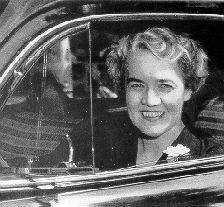
Today in Feminist History is our daily recap of the major milestones and minor advancements that shaped women’s history in the U.S.—from suffrage to Shirley Chisholm and beyond. These posts were written by, and are presented in homage to, our late staff historian and archivist, David Dismore.
September 13, 1948: There’s a celebration going on tonight at the home of Senator-elect Margaret Chase Smith, Republican of Maine, as she adds her biggest triumph to an already long list of achievements.

On January 3rd, she will become the first woman to have ever served in both the House and Senate, and only the sixth woman Senator in U.S. history.
When sworn in, she will become the lone woman in the Senate, since none are serving now, and no others are expected to be elected in the General Election on November second. There are presently six other women in the House, but that number is expected to change due to her departure, as well as the upcoming nationwide elections in which all House seats are up for election.
Though her victory tonight was by an overwhelming 71-29% landslide, the campaign was by no means an easy one. In the Republican primary, she faced three opponents, one of whom is the present governor, and another a former governor.
But thanks to her vigorous campaigning, on June 21st she won more votes than the other three candidates combined. Of course, there was really a fourth opponent, in the form of prejudice against women in politics. When questioned on why a woman should be sent to Washington if a man was available, or if women should even be in politics, she has said:
“Women administer the home. They set the rules, enforce them, mete out justice for violations. Thus, like Congress, they legislate; like the Executive, they administer; like the courts, they interpret the rules. It is an ideal experience for politics.”
Some are saying tonight that the attacks on her candidacy due to her sex caused a backlash, and that this was a particularly poor campaign strategy in a State where most registered voters are women. So, perhaps we’ll see less of that tactic in the future, and more women Senators from Maine.
Her political career goes back to 1930, when she was elected to the Maine Republican State Committee. When her husband died in 1940, she won a special election to fill his House seat, then a regular election to a full term, and has been re-elected to Congress ever since. Among her accomplishments is championing the Women’s Armed Services Integration Act, signed just three months ago by President Truman. It makes women a permanent part of the armed forces, not just an “auxiliary force” to be called upon in wartime than arbitrarily dismissed after victory is won. As a moderate, she supported many parts of New Deal legislation and in 1945 voted against making the House Un-American Activities Committee a permanent body.
She understands the needs of women who work outside the home, having been a schoolteacher, telephone operator, circulation manager for a local newspaper, and textile mill worker. In the 1930s she helped found the Skowhegan Business and Professional Women’s Club.
The first female Senator was Rebecca Felton, Democrat of Georgia, appointed on October 3, 1922 to fill a vacancy due to the death of the incumbent. Sworn in on November 21, 1922, she served only one day. Since a regular election had already occurred by then, and a new Senator elected, he chivalrously allowed her to be sworn in before taking his seat on November 22nd.
The Senate’s second woman, Hattie Wyatt Caraway, Democrat of Arkansas, was appointed on November 13, 1931 to fill her late husband’s seat. She went on to win an overwhelming victory in a special election in January, 1932, and served until January 3, 1945 after having been defeated in the 1944 primary.
Rose McConnell Long, Democrat of Louisiana, was appointed on January 31, 1931 to finish out the term of her assassinated husband, Huey Long. She served until January 3, 1937.
Gladys Pyle of South Dakota was the first Republican woman to gain a seat in the Senate, though it was only to finish out the term of a deceased Senator. She served from November 9, 1936 to January 3, 1937.
Dixie Bibb Graves, Democrat of Alabama, was appointed by her husband, the Governor, on August 20, 1937 to succeed Hugo Black when he was appointed by President Roosevelt to the U.S. Supreme Court. Graves served until she resigned on January 10, 1938.
Though only one of ninety-six Senators, the experience she has gained in the House, and her determination to get things done should give Senator-elect Smith great influence in the Senate once she gets some seniority. At the very least, she will assure that for the next six years – and hopefully many more – the Senate will not be the “Boys’ Club” it has been since Hattie Caraway left just over three and a half years ago.





